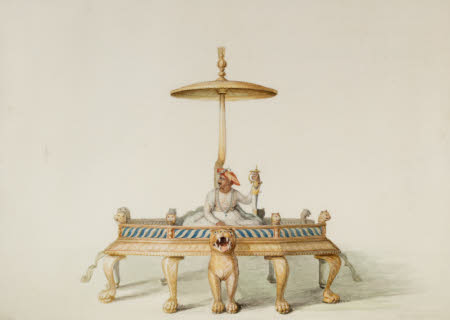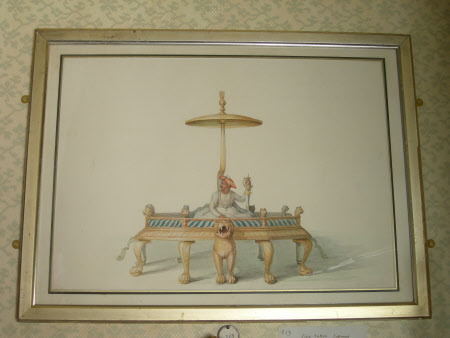Tipu Sultan enthroned
Anna Tonelli (Florence c.1763 – Florence 1846)
Category
Art / Drawings and watercolours
Date
1800
Materials
Watercolour on paper
Measurements
385 mm (H); 532 mm (W)
Place of origin
India
Order this imageCollection
Powis Castle and Garden, Powys
NT 1180776
Summary
Watercolour on paper, ‘Tīpū Sultān enthroned’, by Anna Tonelli (c.1763-1846), July 1800. Tīpū Sultān (1749-99) sits holding his sword on his octagonal throne under a canopy surmounted by a jewelled humā (a mythical bird). The throne is supported by eight cabriole legs with tiger stripes and paw feet, tiger head in centre; tiger head finials (one now at Powis, NT 1180713).
Full description
Anna Tonelli was governess to Henrietta and Edward Clive’s two daughters. They travelled to India in 1798 during Lord Clive’s tenure as the Governor of Madras and stayed there until 1801. During this time Tonelli painted Tīpū Sultān’s throne. Tīpū succeeded his father on the throne of Mysuru in 1782 and established a modern court around his palace at Srirangapatna (Seringapatam). Mysuru was regarded as the strongest and most prosperous state in India and Tīpū its creative and most innovative ruler. He spent much of his reign engaged in the defence of Mysuru against encroachment by the British East India Company. In 1798, a renewed British campaign provoked the Fourth Anglo-Mysore War. On 4th May 1799, during the Siege of Srirangapatna, Tīpū was killed. Tīpū commissioned this octagonal throne of gold ornamented with jewels in 1787. It was modelled as a howdah, or هودج (hawdaj), borne by a tiger. Tīpū Sultān consistently adopted the tiger as an emblem. A huge number of items associated with Tīpū bear representations of tigers and tiger stripes, including arms, coins and book bindings. [Brittlebank, pp. 258-9] The grandeur of the throne was described in a London-printed periodical, the Asiatic Annual Register (1800): 'This throne was of considerable beauty and magnificence. The support was a wooden tiger as life, covered with gold, in the attitude of standing; his head[and] fore legs appeared in front and under the throne, which was placed across his back. It was composed of an octagonal frame, eight feet by five, surrounded by a low railing on which were ten small tiger heads made of gold, beautifully inlaid with precious stones; the ascent to the throne was by small silver steps on each side. From the centre of the back part, opposite the large tiger’s head, a gilded iron pillar rose, seven feet high, surrounded by a canopy superbly decorated with a fringe of pearls. The whole was made of wood, and covered with thin sheet of the purest gold, richly illuminated with [a] tiger stripes and Arabic verses. The huma was placed on the top of the canopy, and fluttered over the Sultan’s head.'’ [Forbes, p. 466] When this description was written, and by the time Anna Tonelli painted this watercolour, the throne had already been dismantled into parts to be auctioned off or given to high-profile British civil and military personnel, as well as the British royal family. Henrietta Clive was given one of the throne finials (NT 1180713). Tonelli painted this watercolour using information from Tīpū’s treasurer and from a sketch made by a Captain Marriot. [Archer et al, p. 134] [1] ‘Tipu Sultan’s Amulet Case’, accessed online at https://www.nms.ac.uk/explore-our-collections/stories/scottish-history-and-archaeology/tipu-sultan/tipu-sultan/tipu-sultans-amulet-case, 10/2/22.
Provenance
Purchased by the National Trust with funding from The National Heritage Memorial Fund from John George Herbert, 8th Earl of Powis and Powis Estate Trustees in August 1999.
Makers and roles
Anna Tonelli (Florence c.1763 – Florence 1846), artist
Exhibition history
Tigers and Dragons: India and Wales in Britian, Glynn Vivian Art Gallery, Swansea, 2025
References
Archer, Rowell and Skelton 1987 Mildred Archer, Christopher Rowell, and Robert Skelton, Treasures from India: The Clive Collection at Powis Castle, London, 1987, p.134, no.213 Chu 2018 John Chu, ‘Game of Thrones in an 'Asiatic World': Henrietta Clive and Anna Tonelli in British India’, National Trust Historic Houses & Collections Annual, 2018, pp.39-45 1995 Brittlebank: K Brittlebank, ‘Sakti and Barakat: The Power of Tipu’s Tiger. An Examination of the Tiger Emblem of Tipu Sultan of Mysore’, Modern Asian Studies 29 2 (1995) Forbes 1834: James Forbes, Oriental memoirs: a narrative of seventeen years residence in India (1834)

